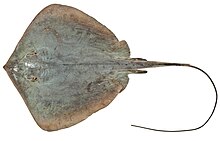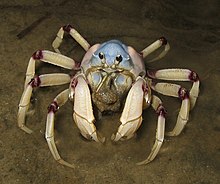Estuary stingray
| Estuary stingray | |
|---|---|

| |
| Scientific classification | |
| Domain: | Eukaryota |
| Kingdom: | Animalia |
| Phylum: | Chordata |
| Class: | Chondrichthyes |
| Subclass: | Elasmobranchii |
| Superorder: | Batoidea |
| Order: | Myliobatiformes |
| Family: | Dasyatidae |
| Genus: | Hemitrygon |
| Species: | H. fluviorum
|
| Binomial name | |
| Hemitrygon fluviorum (J. D. Ogilby, 1908)
| |

| |
| Geographic range[2] | |
The estuary stingray (Hemitrygon fluviorum), also called the estuary stingaree or brown stingray, is a
While the estuary stingray has gained infamy for consuming
Taxonomy
The first reference to the estuary stingray in scientific literature was probably a record by 19th-century English
Description
The estuary stingray has a diamond-shaped
The tail measures twice as long as the disc, and is broad and flattened at the base. On its upper surface is at least one, often two serrated stinging spines. Past the spines, the tail quickly tapers to become whip-like and bears a well-developed keel above and a long, low fin fold beneath. There are wide patches of small
Distribution and habitat

The range of the estuary stingray spans approximately 1,700 km (1,100 mi) along
The
Biology and ecology

Despite its reputation for preying voraciously on
Like other stingrays, the estuary stingray exhibits
Human interactions
Historical and anecdotal evidence strongly suggest that the once-abundant estuary stingray has declined substantially across its range.
The estuary stingray's diminished population and susceptibility to multiple threats have led the
References
- . Retrieved 14 November 2021.
- ^ ISBN 978-0-674-03411-2.
- ISBN 978-2-8317-0650-4.
- ^ Ogilby, J.D. (25 August 1908). "On new genera and species of fishes". Proceedings of the Royal Society of Queensland. 21: 1–26.
- ^ Froese, Rainer; Pauly, Daniel (eds.) (2010). "Dasyatis fluviorum" in FishBase. January 2010 version.
- ^ a b c d Pierce, S.J.; Bennett, M.B. (15 March 2010). "Distribution of the estuary stingray (Dasyatis fluviorum) in Australia". Memoirs of the Queensland Museum. 55 (1): 89–97.
- ^ .
- PMID 26171511.
- ^ S2CID 38462666.
- S2CID 24232674.
- S2CID 2436786. Archived from the original(PDF) on 30 September 2011.
- PMID 9024861.
- S2CID 26375148.
- PMID 19391329.

- ^ doi:10.1071/MF10073.
- ^ Estuary stingray Archived 17 March 2011 at the Wayback Machine (31 August 2007). Queensland Department of Environment and Resource Management. Retrieved 6 November 2011.
External links

